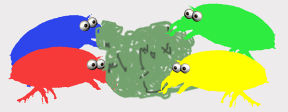UnNews:Scientists photograph elusive "booger" mites
12 March 2007
HONKY SNUFFLE, West Virginia - University researchers today released what they say are the first pictures of dermatophagoides extranasalus, commonly known as the "booger mite".
Scientists believe there are more than 45,000 species of mites, only 5% of which have been found to date. Many mite species live on or around people, and are specialized to feed on specific human waste products like dead skin. Though unseen until now, the booger mite has long been hypothesized. "We knew they were out there," said chief researcher Dr. F.R. "Flicker" Wooley, "or else we'd be up to our ankles in boogers."
Indeed, extranasalus is already the subject of a popular children's book, The Booger Mites, which its author Dr. Snoose describes as "an attempt to explain to small children where their boogers go". Millions of kids, and their parents, can recite such verses from the well-known book as
| “ | They roll them in with rakes and mops, Then cut them into steaks and chops, And sell them in the finest shops. |
” |
Luring the elusive creatures into the open was a group effort involving dozens of students and university staff. "We made a party of it," said Wooley. "One guy would be picking on a banjo, and the rest of us would pick right along with him."
The photos have generated some skepticism in the scientific community. Critics point out the similarity between the mites in the photos and the illustrations in Dr. Snoose's picture book, right down to the bright primary colors and bulging eyes. "I agree it's a mite peculiar," admitted Wooley, explaining "That is mite-ologist humor." But he denied anything unethical is going on. "Of course they have buggy eyes. They're bugs, dammit!"
Investigaive reporters for UnNews got a look at Dr. Wooley's lab and reported nothing unusual. They found typical lab equipment such as microscopes, slides, a scanner, a copy of The Booger Mites, a computer running Photoshop, and a banjo. They said the floor felt "a little gummy."
Dr. Wooley's team also has a grant from the National Science Foundation to study the Appalachian Toejam Mite. Wooley sees quite a future in mite-ology. "There's the question of what happens to booger mites when they die. Are there boggermite mites? And what about boogermite-mite mites? In this business, it's pretty easy to come up with a research topic."


